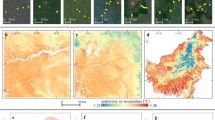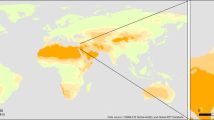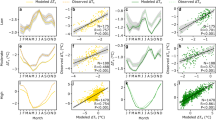Abstract
Macroclimate warming is often assumed to occur within forests despite the potential for tree cover to modify microclimates. Here, using paired measurements, we compared the temperatures under the canopy versus in the open at 98 sites across 5 continents. We show that forests function as a thermal insulator, cooling the understory when ambient temperatures are hot and warming the understory when ambient temperatures are cold. The understory versus open temperature offset is magnified as temperatures become more extreme and is of greater magnitude than the warming of land temperatures over the past century. Tree canopies may thus reduce the severity of warming impacts on forest biodiversity and functioning.
This is a preview of subscription content, access via your institution
Access options
Access Nature and 54 other Nature Portfolio journals
Get Nature+, our best-value online-access subscription
$29.99 / 30 days
cancel any time
Subscribe to this journal
Receive 12 digital issues and online access to articles
$119.00 per year
only $9.92 per issue
Buy this article
- Purchase on Springer Link
- Instant access to full article PDF
Prices may be subject to local taxes which are calculated during checkout


Similar content being viewed by others
Data availability
The datasets and code generated and analysed during the current study are available in the figshare repository37, with the identifier 10.6084/m9.figshare.7604849.
References
Willis, K. J. & Bhagwat, S. A. Science 326, 806–807 (2009).
Scheffers, B. R. et al. Science 354, aaf7671 (2016).
Lenoir, J. & Svenning, J. C. Ecography 38, 15–28 (2015).
IPCC Climate Change 2013: The Physical Science Basis (eds Stocker, T. F. et al.) (Cambridge Univ. Press, 2013).
Moritz, C. & Agudo, R. Science 341, 504–508 (2013).
Devictor, V. et al. Nat. Clim. Change 2, 121–124 (2012).
Dullinger, S. et al. Nat. Clim. Change 2, 619–622 (2012).
Bertrand, R. et al. Nature 479, 517–520 (2011).
Ash, J. D., Givnish, T. J. & Waller, D. M. Glob. Change Biol. 23, 1305–1315 (2017).
De Frenne, P. et al. Proc. Natl Acad. Sci. USA 110, 18561–18565 (2013).
Scheffers, B. R. et al. Glob. Change Biol. 20, 495–503 (2013).
Senior, R. A. et al. Glob. Change Biol. 24, 1267–1278 (2018).
Frey, S. J. K. et al. Sci. Adv. 2, e1501392 (2016).
Dobrowski, S. Z. Glob. Change Biol. 17, 1022–1035 (2011).
Potter, K. A., Arthur, W. H. & Pincebourde, S. Glob. Change Biol. 19, 2932–2939 (2013).
Lenoir, J., Hattab, T. & Pierre, G. Ecography 40, 253–266 (2017).
Bramer, I. et al. in Advances in Ecological Research Vol. 58 (eds Bohan, D. A. et al.) 101–161 (Elsevier, 2018).
Geiger, R. Aron, R. H. & Todhunter, P. The Climate Near the Ground 7th edn (Rowman & Littlefield, 2009).
Guide to Meteorological Instruments and Methods of Observation WMO report No. 8 (World Meteorological Organization, 2008).
De Frenne, P. & Verheyen, K. Science 351, 234 (2016).
Jenkins, C. N., Pimm, S. L. & Joppa, L. N. Proc. Natl Acad. Sci. USA 110, E2602–E2610 (2013).
Millennium Ecosystem Assessment Ecosystems and Human Well-being: Biodiversity Synthesis (World Resources Institute, 2005).
Global Forest Resources Assessment (FAO, 2015).
Jucker, T. et al. Glob. Change Biol. 24, 5243–5258 (2018).
Mayhew, P. J., Jenkins, G. B. & Benton, T. G. Proc. R. Soc. B. 275, 47–53 (2008).
Lejeune, Q. et al. Nat. Clim. Change 8, 386–390 (2018).
Hansen, M. C. et al. Science 342, 850–853 (2013).
Watson, J. E. M. et al. Nat. Ecol. Evol. 2, 599–610 (2018).
Good, S. P., Noone, D. & Bowen, G. Science 349, 175–177 (2015).
Wickham, H. & Bryan, J. Readxl: read excel files. R package v1.0.0. https://CRAN.R-project.org/package=readxl (2017).
Wickham, H. et al. Dplyr: a grammar of data manipulation. R package v0.7.4. https://CRAN.R-project.org/package=dplyr (2017).
Zizka, A. CoordinateCleaner: automated cleaning of occurrence records from biological collections. R package v1.0.7. https://CRAN.R-project.org/package=CoordinateCleaner (2018).
Xie, Y. Knitr: a general-purpose package for dynamic report generation in R. R package v1.2.0. https://yihui.name/knitr/ (2018).
Allaire, J. J. et al. Rmarkdown: dynamic documents for R. R package v1.9. https://CRAN.R-project.org/package=rmarkdown (2018).
Wickham, H Ggplot2: Elegant Graphics for Data Analysis (Springer, 2009).
Wilke, C. Cowplot: streamlined plot theme and plot annotations for ‘Ggplot2’. R package v0.9.2. https://CRAN.R-project.org/package=cowplot (2017).
De Frenne, P., Lenoir, J. & Rodríguez-Sánchez, F. Global buffering of temperatures under forest canopies data and code. Figshare https://doi.org/10.6084/m9.figshare.7604849 (2019).
Amatulli, G. et al. Sci. Data 5, 180040 (2018).
Fick, S. E. & Hijmans, R. J. Int. J. Clim. 37, 4302–4315 (2017).
Bates, D. J. Stat. Softw. 67, 1–48 (2015).
Zuur, A. F. et al. Mixed Effects Models and Extensions in Ecology with R (Springer, 2009).
Gurevitch, J. et al. Nature 555, 175–182 (2018).
Nakagawa, S. & Schielzeth, H. Methods Ecol. Evol. 4, 133–142 (2013).
Barton, K. MuMIn: Multi-Model Inference. R package v1.40.4. https://CRAN.R-project.org/package=MuMIn (2018).
Wood, S. N. Generalized Additive Models: An Introduction with R 2nd edn (Chapman and Hall/CRC, 2017).
Zhu, H., Xu, Z. F., Wang, H. & Li, B. G. Biodivers. Conserv. 13, 1355–1372 (2004).
R Core Team R: A Language and Environment for Statistical Computing (R Foundation for Statistical Computing, 2017); http://www.R-project.org/
André, M. F. et al. Earth Surf. Process. Landf. 37, 519–532 (2012).
Arunachalam, A. & Arunachalam, K. Plant Soil 223, 187–195 (2000).
Asbjornsen, H., Ashton, M. S., Vogt, D. J. & Palacios, S. Agric. Ecosyst. Environ. 103, 481–495 (2004).
Barg, A. K. & Edmonds, R. L. Can. J. For. Res. 29, 705–713 (1999).
Belsky, A. J. et al. J. Appl. Ecol. 26, 1005–1024 (1989).
Blennow, K. Agric. For. Meteorol. 91, 223–235 (1998).
Brower, L. P. et al. Insect Conserv. Divers. 2, 163–175 (2009).
Cachan, P. Ann. Fac. Sci. Dakar 8, 89–155 (1963).
Carlson, D. W. & Groot, A. Agric. For. Meteorol. 87, 313–329 (1997).
Chen, J., Franklin, J. F. & Spies, T. A. Agric. For. Meteorol. 63, 219–237 (1993).
Chen, J. et al. Bioscience 49, 288–297 (1999).
Childs, S. W. & Flint, L. E. For. Ecol. Manage. 18, 205–217 (1987).
Currylow, A. F., MacGowan, B. J. & Williams, R. N. PLoS ONE 7, e40473 (2012).
Daily, G. C. & Ehrlich, P. R. Proc. Natl Acad. Sci. USA 93, 11709–11712 (1996).
Davies-Colley, R. J., Payne, G. W. & van Elswijk, M. N. Z. J. Ecol. 24, 111–121 (2000).
Denslow, J. S. Biotropica 12, 47–55 (1980).
Didham, R. K. & Ewers, R. M. Pac. Sci. 68, 493–508 (2014).
Dovčiak, M. & Brown, J. New For. 45, 733–744 (2014).
Evans, G. C . J. Ecol. 27, 436–482 (1939).
Fetcher, N., Oberbauer, S. F. & Strain, B. R. Int. J. Biometeorol. 29, 145–155 (1985).
Fridley, J. D. J. Appl. Meteorol. Climatol. 48, 1033–1049 (2009).
Gaudio, N., Gendre, X., Saudreau, M., Seigner, V. & Balandier, P. Agric. For. Meteorol. 237-238, 71–79 (2017).
Ghuman, B. S. & Lal, R. Agric. For. Meteorol. 40, 17–29 (1987).
Graae, B. J. et al. Oikos 121, 3–19 (2012).
Granberg, H. B., Ottosson-Löfvenius, M. & Odin, H. Agric. For. Meteorol. 63, 171–188 (1993).
Groot, A. & Carlson, D. W. Can. J. For. Res. 26, 1531–1538 (1996).
Grubb, P. J. & Whitmore, T. C. J. Ecol. 54, 303–333 (1966).
Heithecker, T. D. & Halpern, C. B. For. Ecol. Manage. 248, 163–173 (2007).
Holl, K. D. Biotropica 31, 229–242 (1999).
Honnay, O., Verheyen, K. & Hermy, M. For. Ecol. Manage. 161, 109–122 (2002).
Hopkins, B. J. Ecol. 53, 125–138 (1965).
Ibanez, T., Hély, C. & Gaucherel, C. Austral. Ecol. 38, 680–687 (2013).
Jiménez, C., Tejedor, M. & Rodríguez, M. Eur. J. Soil Sci. 58, 445–449 (2007).
Johansson, D. Acta Phytogeogr. Suec. 59, 1–136 (1974).
Joly, D. Climatologie 11, 19–33 (2014).
Karki, U. & Goodman, M. S. Agrofor. Syst. 89, 319–325 (2015).
Korb, J. & Linsenmair, K. E. Insectes Soc. 45, 51–65 (1998).
Kubin, E. & Kemppainen, L. Acta For. Fenn. 225, (1991).
Lal, R. & Cummings, D. J. F. Crop. Res 2, 91–107 (1979).
Langvall, O. & Ottosson Löfvenius, M. For. Ecol. Manage. 168, 149–161 (2002).
Latimer, C. E. & Zuckerberg, B. Ecography 40, 158–170 (2017).
Lawson, G. W., Armstrong-Mensah, K. O. & Hall, J. B. J. Ecol. 58, 371–398 (1970).
Locosselli, G. M., Cardim, R. H. & Ceccantini, G. Int. J. Biometeorol. 60, 639–649 (2016).
Lofvenius, M. O. Temperature and radiation regimes in pine shelterwood and clear-cut area. PhD thesis, Swedish University of Agricultural Sciences (1993).
Lüdi, W. & Zoller, H. Über den Einfluss der Waldnähe auf das Lokalklima: Untersuchungen im Gebiete des Hardwaldes bei Muttenz (Base) (in German) (Geobotanisches Forschungsinstitut Rübel Zürich, 2018).
Luskin, M. S. & Potts, M. D. Basic Appl. Ecol. 12, 540–551 (2011).
Matlack, G. R. Biol. Conserv. 66, 185–194 (1993).
Meleason, M. A. & Quinn, J. M. For. Ecol. Manage. 191, 365–371 (2004).
Morecroft, M. D., Taylor, M. E. & Oliver, H. R. Agric. For. Meteorol. 90, 141–156 (1998).
Nunez, M. & Bowman, D. M. J. S. Aust. For. Res. 16, 185–197 (1986).
Odin, H., Magnusson, B. & Bäckström, P.-O. Effect of low shelterwood on minimum temperature near the ground. in Ecology and Management of Forest Biomass Production Systems (Perttu, K. ed.) 77–99 (Swedish Unioersity of Agricultural Sciences, Department of Ecology and Environmental Research, Report 15, 1984).
Porté, A., Huard, F. & Dreyfus, P. Agric. For. Meteorol. 126, 175–182 (2004).
Potter, B. E., Teclaw, R. M. & Zasada, J. C. Agric. For. Meteorol. 106, 331–336 (2001).
Renaud, V., Innes, J. L., Dobbertin, M. & Rebetez, M. Theor. Appl. Climatol. 105, 119–127 (2011).
Rodríguez-Sánchez, F., Pérez-Barrales, R., Ojeda, F., Vargas, P. & Arroyo, J. Quat. Sci. Rev. 27, 2100–2117 (2008).
Scheffers, B. R. et al. Proc. R. Soc. B Biol. Sci. 280, 20131581 (2013).
Schulz, J. P. Meded. Bot. Museum en Herb. R.U.U. 163, 1–267 (1960).
Seebacher, F. & Alfrod, R. A. J. Herpetol. 36, 95–98 (2002).
Shanks, R. E. & Norris, F. H. Ecology 31, 532–539 (1950).
Shoo, L. P., Storlie, C., Williams, Y. M. & Williams, S. E. Int. J. Biometeorol. 54, 475–478 (2010).
Sporn, S. G., Bos, M. M., Kessler, M. & Gradstein, S. R. Biodivers. Conserv. 19, 745–760 (2010).
Suggitt, A. J. et al. Oikos 120, 1–8 (2011).
Vajda, A. & Venäläinen, A. Boreal Environ. Res. 10, 299–314 (2005).
Valigura, R. A. J. Environ. Manage. 40, 283–295 (1994).
van Dam, O. Forest filled with gaps: Effects of gap size on water and nutrient cycling in tropical rain forest. PhD thesis, Utrecht University, 2001.
Varner, J. & Dearing, M. D. PLoS One 9, e104648 (2014).
Vitt, L. & Avila-Pires, T. Conserv. Biol. 12, 654–664 (1998).
Williams-Linera, G. J. Ecol. 78, 356–373 (1990).
Xu, M., Qi, Y., Chen, J. & Song, B. Plant Ecol. 173, 39–57 (2004).
Yan, M., Zhong, Z. & Liu, J. Front. Biol. China 2, 62–68 (2007).
Yanoviak, S. P. Selbyana 20, 106–115 (1999).
Young, A. & Mitchell, N. 67, 63–72 (1994).
Moher, D., Liberati, A., Tetzlaff, J., Altman, D. G. & The PRISMA Group PLoS Med. 6, e1000097 (2009).
Acknowledgements
P.D.F. received funding from the European Research Council (ERC) under the European Union’s Horizon 2020 research and innovation programme (ERC Starting Grant FORMICA 757833). K.V. received funding through ERC Consolidator Grant PASTFORWARD 614839. F.R.-S. was funded by a postdoctoral fellowship from the Spanish Ministry of Economy and Competitiveness (FPD-2013-16756). F.Z. was funded by the Swiss National Science Foundation (project 172198). M.V. was funded by the Natural Sciences and Engineering Research Council, Canada.
Author information
Authors and Affiliations
Contributions
P.D.F., F.Z. and J.L. conceived and designed the research. P.D.F., F.Z., J.L. and F.R.-S. assembled and revised the database and analysed the data. All authors compiled data and wrote the manuscript.
Corresponding author
Ethics declarations
Competing interests
The authors declare no competing interests.
Additional information
Publisher’s note: Springer Nature remains neutral with regard to jurisdictional claims in published maps and institutional affiliations.
Supplementary information
Supplementary Information
Supplementary Figures 1–8 and Supplementary Tables 1–8
Rights and permissions
About this article
Cite this article
De Frenne, P., Zellweger, F., Rodríguez-Sánchez, F. et al. Global buffering of temperatures under forest canopies. Nat Ecol Evol 3, 744–749 (2019). https://doi.org/10.1038/s41559-019-0842-1
Received:
Accepted:
Published:
Issue Date:
DOI: https://doi.org/10.1038/s41559-019-0842-1
This article is cited by
-
Weather-dependent changes in habitat use by Alpine chamois
Movement Ecology (2024)
-
Extinction drives recent thermophilization but does not trigger homogenization in forest understorey
Nature Ecology & Evolution (2024)
-
Drought response of the boreal forest carbon sink is driven by understorey–tree composition
Nature Geoscience (2024)
-
Reassessment of the risks of climate change for terrestrial ecosystems
Nature Ecology & Evolution (2024)
-
Enhanced stability of grassland soil temperature by plant diversity
Nature Geoscience (2024)



